Detroiters have more access to grocery stores per capita than its suburbs.
Mainstream media often refers to Detroit as a “food desert,” an urban area where it is difficult to buy affordable or high quality food. There just aren’t enough grocery stores, reports say, as chain supermarkets refuse to open locations in the city. This lack of healthy options accounts for the food insecurity and obesity many Detroiters experience. But my experience and the data reveal a more complicated picture, that Detroit has a large selection of full-service grocery stores within city limits. Moreover, the language of the “food desert” and the focus on large chain stores fail to help us understand and improve nutritional access in the city.
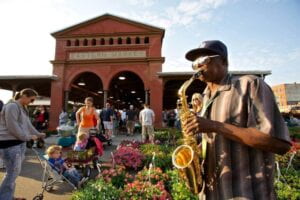
Detroit’s Eastern Market serves as a fresh produce, meat, and brewery hub for both consumers and wholesale businesses. (source: littleguidedetroit.com)
Living in the neighborhoods away from the glittering downtown condos, I may not have had access to the big chain grocers but I was still never more than a mile’s walk away from multiple full-service grocery stores . If I got in my car, my options expanded even more — including full service-groceries, limited assortment stores, farmer’s markets, and community gardens, all within city limits. My experience could not represent that of every Detroiter, but despite the serious problems discussed in the news, I saw a thriving urban food scene encompassing residents of all income levels.
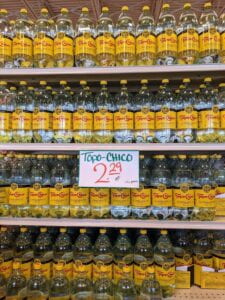
The sparkling water section at Detroit’s Honey Bee Market. Also available but not pictured: affordable meat selections, an embarrassment of fresh produce, and a high quality Mexican deli counter.
Using data on grocery store locations from the Southeast Michigan Council of Governments (SEMCOG) and population data from the census, I compared Detroit’s grocery access to that of its suburbs to see if it really is a food desert.
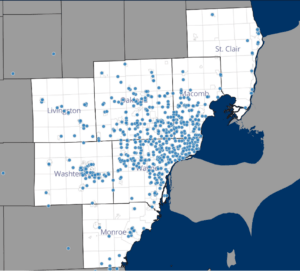
Grocery stores in Southeast Michigan. The city of Detroit is at the center of the map, within Wayne County. (SEMCOG)
My analysis went against the common media portrayal of food deserts in Detroit. In fact, Detroit has more grocery stores for its population compared to the suburbs. The tri-county metro area a whole has about 0.113 grocery stores per 1,000 residents. The city itself has 0.134 grocery stores per 1,000 residents.
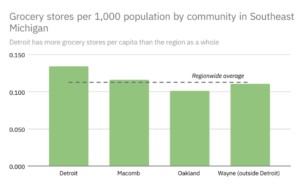
Source: SEMCOG, US Census Bureau
But this might not tell the whole story. With high rates of obesity and poverty in Detroit, the quality, price, and diversity of food are key considerations. SEMCOG categorizes grocery stores as supermarkets or limited assortment stores. A supermarket is your typical large grocery store with a full line of fresh produce, meat and other essentials. A limited assortment store is smaller and has fewer fresh or perishable offerings — think a dollar store or discount market.
Breaking down the stores within each community by category, we find that Detroit actually has more supermarkets than limited assortment stores compared to the suburbs. 88% of Detroit’s grocery stores are full-service supermarkets, compared to 83% in affluent Oakland County.
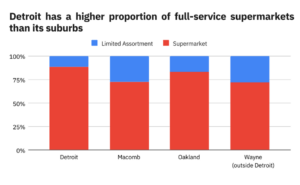
Source: SEMCOG
Despite the conception of Detroit as a blighted food desert where residents must leave the city to buy basic necessities, we found that the city is abundantly served by large grocery stores offering fresh foods. This confirms the intuition and lived experience of myself and my fellow residents.
It’s still clear that this abundance is not benefitting all Detroiters. With 48% of households experiencing food insecurity and 38% of residents obese, much more work needs to be done for food justice. Yet my analysis suggests that simply adding more grocery stores may not be the solution. Grocery stores need to be accessible within the city and serve the needs of residents.
Food deserts could still be occurring in some areas of the city — a geospatial analysis could identify specific poorly-served neighborhoods. Indeed, the US Department of Agriculture finds that fewer than 10% of census tracts in Detroit meet its definition of a “food desert.” We also have limited information on costs and quality within grocery stores. If stores don’t meet the cost and health needs of residents, they could be contributing to high food insecurity and obesity.
Local advocates support solutions that acknowledge complexities of food systems and retail in Detroit. For example, the Detroit Food Policy Council takes a more nuanced approach, emphasizing the need for better transportation and specifically the need for neighborhood retail that residents can easily access and afford. It also studies the impact of farmer’s markets and community gardens, which discussions of food deserts often omit in favor of large supermarkets. Finally, it suggest the term “food apartheid” to replace “food desert” as a recognition that Detroit’s food issues are not natural – they result from redlining and racial discrimination.
Let’s continue to take a data-driven, not a myth-driven, approach to food justice in Detroit.
You can reach the author of this piece, Calley Wang, at: csw9856@nyu.edu
You can reach the editor of this piece, Patrick Spauster, at: ps4375@nyu.edu